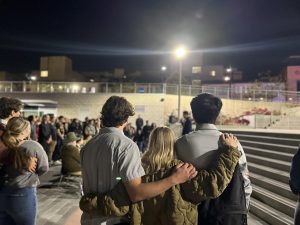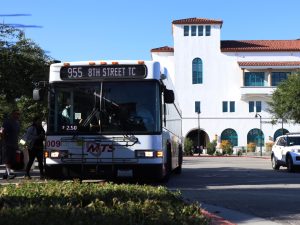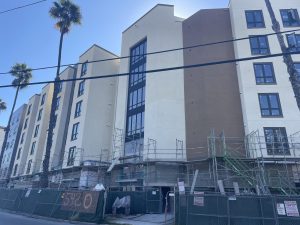The men’s voices from above shouted, “We’ll make soap out of you!”
Blindfolded and thrown to the backseat floor of a car, then-24-year-old Nora Strejilevich listened to the words of the men whose boots dug into her back. On a ride to what could possibly end in her death, they made it clear that they didn’t care what she had done. She was Jewish.
Moments before, Strejilevich had been in her family’s apartment packing her suitcase in preparation for a year-long study abroad trip to Israel. It was early afternoon on a wintery day in July 1977, when the “grupo de tarea” declared a free zone, stopping all activity in or out of her busy neighborhood in Buenos Aires, Argentina and raided her parents’ home.
The men forced her parents into another room while they kidnapped her. She screamed they were taking her. On the street she screamed her name, hoping someone on the street would at least hear it.
This is how Strejilevich became, for a short time, a “desaparecida” and for a lifetime, a survivor of political extermination. She shared her story at San Diego State in an attempt to give meaning to a particularly dark point in history.
An entire generation of Argentines, mostly leftist union workers and students, were targeted by military juntas as subversives, kidnapped, tortured and often killed in Argentina. They’re called “los desaparecidos”–the disappeared–because many of them have never been found, dead or alive.
Horrific stories have been documented by a truth commission about “vuelos de la muerte” – death flights. The military would sedate prisoners with the short-acting anesthetic Pentothal, tie their hands behind their backs and send them up into a small plane where they were thrown, alive, into the Atlantic Ocean.
“Those flights were every Wednesday,” Strejilevich said. “The victims were thrown alive but the military calculated that the fish would eat the meat so that the bodies wouldn’t be found.”
According to a 1984 report by the National Commission on the Disappearance of Persons, beginning in mid-1976 bodies were found washed ashore with “unmistakable signs of violence; the salt water and predatory fish had disfigured nearly all of them.”
Usually, they weren’t found. It was as if the kidnapped had vanished, leaving lasting scars upon the hearts of those who loved them; visiting cicatrices that occupy both the memory and writings of Strejilevich, who is now a Latin American Studies professor at SDSU.
As a liberated prisoner from a secret detention center referred to as the “Athletic Club” in San Telmo, Argentina, Strejilevich’s memory of her torture, her literary testimony, is preserved in her book “A Single Numberless Death.” She is also the surviving sister and cousin of three “desaparecidos.” CONADEP recorded the forced disappearance of about 9,000 Argentines. It also noted that the actual amount is believed to be much higher. Some human rights groups have estimated the number to be as high as 30,000.
Late last month, Argentina commemorated the anniversary of the 1976 military coup d’état, led by Gen. Jorge Videla, that overthrew the presidency of Isabel Martínez de Perón. Her attempts to extinguish the increasingly volatile leftwing guerillas fizzled. Instead, the military junta ignited a decade of state-sponsored genocide commonly called the “Dirty War,” also known as “La Guerra Sucia;”
“They considered it a war but we call it state terror or, rather, genocide,” Strejilevich said. “Dirty War is not the right interpretation according to us, those affected by crimes against humanity. That’s why we don’t use it.”
Her older brother, Gerardo Strejilevich, was kidnapped the day before she was. He was active in “Juventud Peronista,” a political group that wanted social justice and equal treatment for the working class. This was one of many branches of the Peronist, whose collective goals were to achieve economic independence and political sovereignty from U.S. policies.
“In the ‘70s there was a wave of revolutionary spirits all over Western countries,” Strejilevich said. “Some groups in the big spectrum of rebellion were pro-guerilla and they used violence against certain targets. At the time, violence was accepted. The idea was simple: When there’s violence from above, if you don’t respond with violence from below at certain moments probably you’d just lose the game.”
However, Strejilevich said those involved in “violence from below” didn’t realize how powerful the “violence from above” was. According to her, Argentines were experiencing one part of a larger Condor Plan.
“It was a methodology of political control among Southern Cone dictatorships involving the kidnapping and assassination of prisoners,” she said. “U.S. involvement in this plan is not news in Latin America.”
At the time, Strejilevich said she didn’t expect to be targeted as subversive because the extent of her involvement in the resistance was minimal. She attended a few demonstrations and went to meetings in search of like-minded fellowship, but couldn’t find one group she completely agreed with.
Later, Strejilevich realized that the military’s definition of subversive was broad. “Anybody who had ideas that were contrary to what they called ‘Western Christian’ society were enemies,” Strejilevich said. “So I was an enemy anyway.”
Well respected journalists were disappeared. Women were kidnapped and killed, their babies were given to “good” couples who would envelope the next generation in pro-militia propaganda.
Sitting in her office in the Arts and Letters building, Strejilevich is a tiny woman with warm eyes and a deep voice. She calmly and deliberately explained the unimaginable events of her past, interrupting the flow of questions only to reschedule a later appointment with a colleague.
“I wasn’t as involved as others, not because I didn’t agree with the need for change; I was just not convinced about the violence,” she said. “I just cannot support violence. I never did.”
SDSU Spanish Professor Laura Farfán has known Strejilevich for eight years. She grew up in Jujuy province during the time of the military junta’s government rule. Farfán said she was mostly sheltered from the violence by her middle / upper class upbringing but some of the intrinsic effects of terrorism remain with her today.
“Growing up I have memories of my parents teaching me to be aware of military and police and to stay away from uniformed persons,” Farfán said. “Anytime there’s a cop in a uniform, even today, it gives me the chills. When I see soldiers here at school, it makes me a little nervous and I didn’t go through what Nora had to go through. Nora gets really nervous.”
Nervous as a result of the torture she endured at the Athletic Club.
Upon arrival at the detention center, Strejilevich, blindfolded, was immediately subjected to two back-to-back torture sessions with an electrical prod.
She said her hands were tied to a bed, “like a Jesus Christ figure,” and terminals placed on her body. “It can be placed inside of you, in very sensitive parts of your body,” Strejilevich said. “Imagine if that is done every second all over your head, breasts, feet, all constantly, constantly. It’s unbearable. You want to die. After that it was the first time that I wanted to die,” she said.
Dumped in a cold isolated cell in the basement and shackled, Strejilevich heard a familiar voice. It was her brother screaming. He had been taken to the Athletic Club too, but never made it out.
She remembers taking the risk of talking to a young man being held across the corridor from her who had been at the camp for six months. He told her the military would tell people they were being transferred, but that might mean liberation or it might mean death.
A few days later, she was told she was being transferred.
“When they came for me, they took me upstairs and they sat me on the floor,” Strejilevich said. “I thought, ‘well, maybe this is liberation or maybe they’re going to kill me.’ I didn’t know.”
They put her in a car and drove her to a different part of the city. They instructed her to count to one hundred and lift her blindfold. When she did, she found herself amid the familiar restaurants of the Buenos Aires neighborhood called La Boca at 4 a.m. She had been liberated.
Wearing only a T-shirt in the middle of winter, she walked around not knowing if her captors were coming back for her. She entered a restaurant where patrons were celebrating and asked for the phone. She called home but didn’t want her mother to come get her. She asked for change for the round-the-clock buses that ran in Buenos Aires back then, but as she was boarding, a police car approached. She was brought to the police station and questioned, but she told nothing of her abduction, fearing they were sent by the military to test her.
She didn’t have to say much because the welts spread ubiquitously over her bare arms confessed what she was too wise to say aloud. The police drove her home without ever officially recognizing her disappearance.
Strejilevich never told her parents the details of her torture, so as to spare them further agony. It was a conflicted time for her family as they both celebrated her release and ached for her brother.
She promptly fled to Israel and became an exile. In 1983, democracy was restored in Argentina and the new administration announced that “Los Desaparecidos” should be considered dead. Strejilevich’s mother, already sick with grief, fell gravely ill and Strejilevich finally returned home to be with her.
Although she said much has changed during her absence, one thing remained the same. Despite the revelation of the magnitude of human rights abuses inflicted upon the people of Argentina, the media chose to shroud the past in secrecy. Today, the almost daily court trials of members of the military junta, torturers and priests aren’t published in most traditional newspapers, but rather in alternative media devoted to covering human rights issues.
Many citizens also want to leave this chapter behind. Even Strejilivich’s extended family never asked her questions. “There must be a reason, they used to say,” she said.
Farfán said throughout their friendship, she wouldn’t ask her pointed questions about the past. “I don’t like asking because I know it’s a very delicate subject for her,” Farfan said. “Me, as a friend? I can’t. I can’t. It’s just me, I can’t do it. It’s too painful.”
Latin American Studies major Carlo Vasquez is one of Strejilevich’s students, and echoes Farfán’s reluctance to question her. “It’s obvious that it’s still, even after all this time; it’s still fresh in her mind,” he said.
Despite the discomfort of those around her, Strejilevich has made a career of remembering and testifying. She said teaching and opening a space for debate about this topic is one of the most meaningful things she has done in the U.S.
“It just happened that I survived,” she said. “There is a responsibility in that. I cannot believe going through this catastrophe and then coming out and trying to lead the life of everybody else pretending that it didn’t happen.”
Dr. Strejilevich is currently a lecturer at San Diego State University. Her class, Bearing Witness: Testimony in Latin America covers a wide range of human rights abuses that occurred throughout the Americas including the genocide in Argentina.









